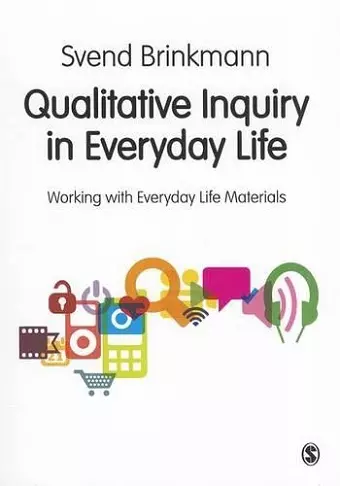Qualitative Inquiry in Everyday Life
Working with Everyday Life Materials
Format:Hardback
Publisher:Sage Publications Ltd
Published:23rd Jul '12
Currently unavailable, and unfortunately no date known when it will be back
This hardback is available in another edition too:
- Paperback£44.99(9780857024763)

This book is a ′survival guide′ for students and researchers who would like to conduct a qualitative study with limited resources. Brinkmann shows how everyday life materials such as books, television, the internet, the media and everyday conversations and interactions can help us to understand larger social issues.
As living human beings in cultural worlds, we are constantly surrounded by ′data′ that call for analysis, and as we cope with the different situations and episodes of our lives, we are engaged in understanding and interpreting the world as a form of qualitative inquiry. The book helps its reader develop a disciplined and analytic awareness informed by theory, and shows how less can be more in qualitative research. Each chapter introduces theoretical tools to think with, and demonstrates how they can be put to use in working concretely with everyday life materials.
Brinkmann′s text works out of the well-established tradition of everyday life studies and the critical narrative framework developed by Steinar Kvale. It is clearly written, it is accessible, it has good examples and it systematically works through the use and study of self-observations, conversations, media, cinema, and literature
Norman Denzin
University of Illinois, Urbana-Champaign
Overall, Brinkmann adds a welcome and informative contribution to the existing body of research methods literature. He presents and explains the varying theoretical and practical aspects of carrying out a relatively new and unexplored type of qualitative inquiry-everyday life research. Brinkmann’s arguments are clearly articulated, and where appropriate, often supplemented by commentary on his own personal research experiences, breakdowns of key terms and concepts, and practical exercises/points for reflection. With the exception of a few areas, in which Brinkmann might have expanded the range of issues discussed (relating to ethics), or made some points clearer (on approaches involved in self-observation studies), this book could be considered very readable, accessible, and would make a useful point of reference for students, academics and researchers alike.
Emma Smith
Book reviews, Methodspace
The book could be used interdisciplinary, in different scientific areas - by sociologists, psychologists, philosophers, experts in literature, even the ordinary reader who is interested in a more scientific approach to everyday life events and experiences.
Stanislava Stoyanova
Methodspace
Brinkmann immediately won my interest in his book with his less is more argument... In each chapter, he provides a deeply theoretical analysis of the source and methods of studying it, lightened by an extended illustrative example exploring some aspect of the new experience or expression of guilt and shame... Throughout this book, Brinkmann is drawing on his extensive knowledge of philosophical, psychological and literary sources to argue for and exemplify a style of research that draws on points of breakdown, when everyday expectations aren′t met. This book is not for the faint hearted... This is a book for the serious researcher, one from which, if you are prepared to put in the work to read, study, and apply, you will reap stimulating ideas and rich intellectual rewards.
Pat Bazeley
Books Reviews, Methodspace
Brinkmann successfully achieves ‘conceptual audacity’ in his text. It comes across as multilayered, rich in description, and analysis, while at the same time providing a valuable stock of qualitative theory, and useful examples. This is an inspiring textbook, which would be useful to novice and experienced qualitative researchers alike. -- Iona Tanguay
ISBN: 9780857024756
Dimensions: unknown
Weight: 500g
208 pages